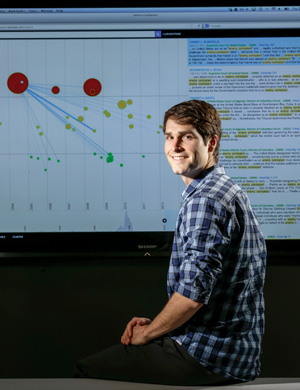LexisNexis acquires case analytics firm Ravel Law

Ravel Law CEO Daniel Lewis. ABA Journal file photo by Tony Avelar.
LexisNexis Legal & Professional has acquired legal research and litigation analytics firm Ravel Law, and will integrate Ravel's data visualization and profiling technology into LexisNexis services.
“Ravel Law will accelerate our vision of the data-driven lawyer of the future,” says Jeff Pfeifer, vice president of LexisNexis product management, in an interview after Thursday’s announcement. “By leveraging these platforms, an attorney can get insights about a variety of problems, from judicial tendencies to arguments that are effective in a judge’s chambers.”
Ravel Law chief executive Daniel Lewis and chief operating officer Nik Reed will join LexisNexis senior leadership, Pfeifer tells the ABA Journal.
“The deal will expand our reach incredibly, and take something that tens of thousands of lawyers have grown to love and rapidly expand its impact,” says Lewis, who will work with Pfeifer in a product role. “We shared the direction of moving to machine learning and artificial intelligence, and they thought Ravel Law could be an important part of that story.
“We think we can help lawyers do the kinds of things they’ve done with greater confidence,” Lewis adds. “They’ll be able to manage a greater amount of information, and to uncover trends and patterns that can make them more effective.”
Lewis and Reed started Ravel Law in 2012 as an outgrowth of Stanford University projects in law, computer science and design, including the CodeX legal informatics center. Their research tools use machine-learning techniques to classify litigation records and analyze the actions of judges, courts and law firms.
In 2018, LexisNexis plans to incorporate Ravel Law’s machine-learning technology into the Lexis Litigation Profile Suite, which tracks expert witnesses and judges, and will integrate its visual display into the Lexis Advance case law database.
“Lexis has asked our entire team to stay on,” says Lewis, who will take a still-to-be-named product role. Engineering vice president Adam Pingel will also continue on, and LexisNexis will maintain a base in San Francisco, Lewis says.
The two parties did not disclose terms. LexisNexis has been moving to adopt advanced analytics tools, both in its own technology upgrades and the 2015 acquisition of the Lex Machina case-docket platform.
Lewis envisions LexisNexis extending the technology to regulatory and legislative data. “However, we really see this, first, as an opportunity in core litigation use cases, where we can offer new insights in case opinions,” he says.
In the next few months, the team will complete its project with Harvard University to digitize the school’s case law library, and Lewis notes that LexisNexis will consider ways to support the effort. “We’ll continue to provide public access and expand it with APIs,” Lewis says, referring to the application program interfaces that developers use to distribute information.
For his part, Pfeifer sees informatics technology as a way of making analytics more accessible. “We don’t want lawyers to think, ‘I’m doing an analytic task today,’” he says. “It’s important that our products are intuitive. We can drive real value and help even non-technology-centric lawyers with the kind of data that’s available.”
See also:
ABA Journal: “LexisNexis will integrate judge analytics in research platform, discontinue sales of Firm Manager”
ABA Journal: “As governments open access to data, law lags far behind”
ABA Journal: “Visual law services are worth a thousand words—and big money”
Write a letter to the editor, share a story tip or update, or report an error.


